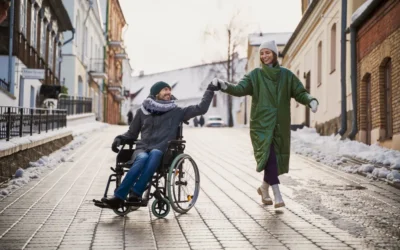Health & Fitness for People with Mobility Challenges: A Comprehensive Guide
Health and fitness play an important role in everyone’s life—including individuals with mobility challenges. While mobility limitations may require modifications or adaptive strategies, maintaining an active lifestyle is not only possible but also highly beneficial. Whether you use a wheelchair, walker, or other mobility aid, there are effective, safe, and empowering ways to improve your physical and mental well-being.
Why Staying Active Matters
Engaging in regular physical activity offers a wide range of benefits that go beyond just physical appearance or weight control. For people with mobility challenges, it can help maintain independence, reduce the risk of health complications, and contribute to emotional resilience.
Some of the key benefits include:
- Improved cardiovascular health
- Increased muscle strength and joint flexibility
- Better posture, balance, and coordination
- Lower risk of chronic diseases such as diabetes and heart disease
- Improved mood, reduced anxiety, and enhanced self-esteem
- Greater independence in daily life
It’s also worth noting that regular movement—no matter how light—can boost energy levels and overall quality of life.
Getting Started Safely
Before beginning any exercise program, it’s important to take a few foundational steps to ensure your routine is safe, effective, and enjoyable:
- Consult a healthcare provider or physical therapist: A professional can assess your current mobility level and health conditions to suggest exercises that are right for you.
- Set SMART goals: Your goals should be Specific, Measurable, Achievable, Relevant, and Time-bound. For example, “I want to do seated exercises three times a week for 20 minutes.”
- Track your progress: Keep a simple log of your activities and how you feel afterward. This helps measure improvements and keeps you motivated.
- Start slow and build gradually: Consistency is more important than intensity at the beginning.
Best Exercise Options for Mobility Challenges
Seated Cardio Workouts
Cardiovascular exercises can be adapted to seated or limited-mobility formats that still get the heart rate up and improve endurance:
- Arm cycling using a hand cycle machine
- Seated boxing or shadow boxing routines
- Chair dancing or wheelchair aerobics
- Marching or tapping feet while seated
Strength Training
Strength training helps maintain muscle tone and bone density, which are especially important for supporting the joints and managing daily activities:
- Resistance bands for upper and lower body
- Light dumbbells or weighted household items
- Seated leg lifts, arm curls, and shoulder presses
- Core engagement through seated exercises
Flexibility and Stretching
Stretching helps reduce stiffness, prevent injury, and improve comfort. Flexibility routines can be adapted to your range of motion:
- Daily seated or lying down stretches
- Gentle yoga or adaptive yoga sessions
- Assisted stretching with a caregiver or partner
Core and Balance Work
Even from a seated position, you can work on your core strength, which is essential for posture, balance, and stability:
- Seated core twists and side bends
- Controlled breathing with posture focus
- Stability ball exercises (if balance permits)
Aquatic Therapy
Water-based exercise is especially gentle on the joints and ideal for those who experience pain or pressure during weight-bearing activities:
- Swimming or pool walking
- Water aerobics or group therapy classes
- Hydrotherapy for relaxation and rehabilitation
Accessible Equipment and Modifications
Thanks to advances in inclusive design, many tools and machines are available to support adaptive fitness:
- Hand cycles and pedal exercisers for home or gym use
- Resistance bands with grips or loops
- Adaptive gym equipment with wheelchair access
- Strap-on wrist and ankle weights
- Grip aids to hold weights securely
These can be used at home or in accessible gyms. If unsure how to use any of them, seek guidance from a trainer with experience in adaptive fitness.
Staying Motivated and Safe
Staying consistent with an exercise routine can be challenging, but finding ways to stay engaged makes a big difference. Here are some helpful tips:
- Find a fitness buddy or join online communities for support
- Use fitness apps or YouTube channels designed for adaptive workouts
- Incorporate exercise into daily life, like during TV time or breaks
- Listen to your body—rest when needed and avoid pushing through pain
- Stay hydrated and eat well, supporting recovery and energy
Progress may come gradually, but consistency builds confidence and results.
Mental and Emotional Benefits
Exercise not only supports your physical health—it also has a profound impact on emotional well-being. It can help reduce feelings of stress or anxiety, lift your mood, and provide a sense of achievement. Participating in group classes, either online or in person, can also offer social interaction and reduce feelings of isolation.
Some key mental benefits include:
- Reduced depression and anxiety
- Improved mood and mental clarity
- Increased self-esteem and body confidence
- A stronger sense of autonomy and control
Real-Life Inspiration
All over the world, people with mobility challenges are showing that fitness is for everyone. From adaptive CrossFit athletes to wheelchair marathoners and dancers, countless individuals are pushing boundaries, challenging stereotypes, and redefining what it means to be strong and healthy. Their stories are proof that disability does not mean inactivity—it simply means doing things differently.
Final Thoughts
Health and fitness should be accessible to all, and mobility challenges should never be seen as a barrier to staying active. With the right support, adaptive tools, and a positive mindset, anyone can develop a fulfilling and enjoyable fitness routine. Whether you’re starting with small stretches or training for a specific goal, remember that every step, push, or movement counts.
Stay active, stay empowered, and most importantly—move in a way that feels right for you. Your journey is your own, and there’s strength in every moment of it.


